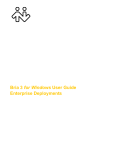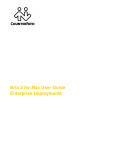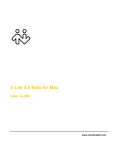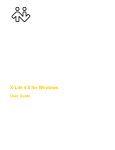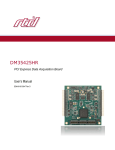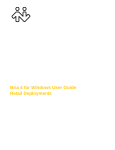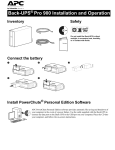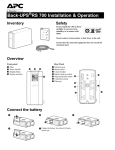Download Bria 3.1 for Linux User Guide
Transcript
Bria 3.1 for Linux User Guide CounterPath Corporation CounterPath Corporation Suite 300, One Bentall Centre 505 Burrard Street, Box 95 Vancouver, BC V7X 1M3 Tel: 604.320.3344 [email protected] www.counterpath.com © July 2010 CounterPath Corporation. All rights reserved. This document contains information proprietary to CounterPath Corporation, and shall not be used for engineering, design, procurement, or manufacture, in whole or in part, without the consent of CounterPath Corporation. CounterPath and the logo are trademarks of CounterPath Corporation. The content of this publication is intended to demonstrate typical uses and capabilities of the CounterPath Bria 3 for Linux softphone application from CounterPath Corporation. Users of this material must determine for themselves whether the information contained herein applies to a particular IP-based networking system. CounterPath makes no warranty regarding the content of this document, including—but not limited to—implied warranties of fitness for any particular purpose. In no case will CounterPath or persons involved in the production of this documented material be liable for any incidental, indirect or otherwise consequential damage or loss that may result after the use of this publication. This manual corresponds to Bria 3 for Linux version 3.1. Revision 1 2 Contents Introduction...................................................................................................................................1 Installation and Setup....................................................................................................................3 Starting Bria ............................................................................................................................3 Configuring Bria .....................................................................................................................4 Setting up a Contact List.........................................................................................................5 Checking for Bria Updates .....................................................................................................5 Using Bria .....................................................................................................................................7 Starting and Quitting Bria.......................................................................................................7 The Onscreen Softphone.........................................................................................................7 Placing a Call ..........................................................................................................................9 Handling Incoming Calls ........................................................................................................12 Handling an Established Call..................................................................................................14 Transfering a Call ...................................................................................................................15 Conference Calls.....................................................................................................................16 Voicemail................................................................................................................................18 Forwarding Calls.....................................................................................................................18 Using Resources ...........................................................................................................................19 Contacts Tab ...........................................................................................................................19 History Tab .............................................................................................................................23 Directory Tab ..........................................................................................................................24 Bria Preferences ............................................................................................................................25 A Application Hot Keys ...............................................................................................................31 B Contact List Headings ...............................................................................................................32 C Run Bria from a Hyperlink .......................................................................................................33 D Glossary ....................................................................................................................................34 i CounterPath Corporation ii 1 Introduction This manual is intended for two types of users: • • Users in an enterprise. These users typically have a system administrator who has set up Bria ready for use. “Retail” users. These users are working in a non-office environment and are their own system administrator. If you are a retail user, you must also read the “Bria 3 for Linux Administrator Guide”. Standard Telephone Features Bria is a softphone from CounterPath that enables you to make VoIP phone calls. It has all standard enterprise telephone features, including: • • • • • • • Call display and Message Waiting Indicator (MWI). Speakerphone and Mute. Redial, Hold, Do Not Disturb. Call history – list of received, missed, and dialed calls. Call forward. Call transfer. Six-party audio conferencing. Enhanced Features and Functions Bria also supports the following features and functions: • • • • • • Contact list containing the individual user’s contacts. Directory containing names from a shared LDAP directory. Automatic detection and configuration of audio devices. Acoustic echo cancellation, automatic gain control, voice activity detection. Support for DTMF (RFC 2833 or inband DTMF). Support for the following audio codecs: DVI4, DVI4 Wideband, G.711aLaw, G.711uLaw, G.729, GSM, iLBC, L16 PCM Wideband, Speex, Speex FEC, Speex Wideband, Speex Wideband FEC. • Automatic selection of the best codec based on the other party’s capability, the available bandwidth, and network conditions. Bria switches the codec within a call in response to changing network conditions. Compliance to 3261 SIP standard. Support for these firewall traversal solutions: STUN, TURN, or ICE. • • 1 CounterPath Corporation 2 2 Installation and Setup 2.1 Starting Bria First-time Startup 1. If Bria is not already running, start it by choosing Applications > Internet > Bria from the Linux menu. The Bria Login dialog appears with the Profile set to “No login required”. r 2. If you are an enterprise user, set the profile to the value specified by your system administrator. If you are a retail user, you will typically choose “No login required”. • • No login required: Used if you will manually configure Bria, as described below. Manually configure login server: Used if Bria will be automatically configured for you but you must manually enter the server address (as provided by your system administrator). 3. If you chose the “Manually configure” profile, the login dialog appears for you to enter the login server and your credentials. This information is provided by your system administrator. 4. Enter the login information and click OK; the softphone appears. Subsequent Startups After the first-time startup, the Bria Login dialog will not appear if you selected the No login required profile. (If you started up the first time with “No login required” but in fact you do need to log in, go to the menu and choose Bria > Preferences and enable login. See page 25.) 3 CounterPath Corporation 2.2 Configuring Bria Do You Need to Read this Section? Read this section if you are an enterprise user and your system administrator advises you that you must either configure Bria or complete the configuration. If you are an enterprise user and your administrator advises you that configuration is already done, go to “Setting up a Contact List” on page 5. If you are a retail user, skip the rest of this chapter and instead read the “Bria 3 for Linux Administrator Guide” for complete instructions on configuring Bria. 1. From the Bria menu, choose Bria > Account Settings. The Account list appears. 2. Choose Add; the SIP Account window appears. 3. Set up the first SIP account as instructed by your administrator. 4. When done, click OK. The account is enabled and registered. 4 Bria 3 for Linux User Guide 2.3 Setting up a Contact List Typically, you will want to create contacts in order to easily make phone calls, send IMs and transfer files. You can set up contacts in several ways: • • • • During a call that you place or receive, you can add the other party to your contact list. See “Handling an Established Call” on page 14. You can add addresses to the Contact list one by one. See page 21. You can import a contact list from a file or from another application. See page 20. You can create a contact from an entry in the corporate directory, if your administrator has set this up; see “Directory Tab” on page 24. For general information on contacts, see page 19. 2.4 Checking for Bria Updates Your system administrator should tell you about the policy for checking for and installing upgrades. To check for updates to Bria, choose Help > Check for Updates. The Auto Update window appears. • • If a new version of the software is available, you can download it from this window. If no newer version is available, this window informs you that your version is up to date. 5 CounterPath Corporation 6 3 Using Bria 3.1 Starting and Quitting Bria If Bria is not already running, start it by choosing Applications > Internet > Bria from the Linux menu. To quit Bria, click Bria > Exit or press Ctrl-Q. 3.2 The Onscreen Softphone Voicemail Bria menu. See below. Missed calls Exit Bria Call entry field See page 9. Show/hide dial pad Resources. See page 19 7 CounterPath Corporation The Bria Menu Bria • • • Account Settings. If you are an enterprise user, you will work with these settings only if advised to do so by your system administrator. If you are a retail user, select this menu item to configure Bria. See the “Bria 3 for Linux Administrator Guide”. Preferences. These settings control the way that you work with Bria and apply to all accounts. If you are an enterprise user, see “Bria Preferences” on page 25. If you are a retail user, see “Bria 3 for Linux Administrator Guide”. Exit. To shut down Bria. You can also exit by pressing Ctrl+Q. View Changes how Bria looks. Contacts Lets you work with contacts. Actions Lists the actions that you can perform, depending on the current “state” of Bria. For example, if a contact is selected, it lists all the actions that can be performed on that contact. Help Provides access to various service-related features. 8 Bria 3 for Linux User Guide 3.3 Placing a Call You can contact someone using: • • A traditional phone number, if supported by your VoIP service provider. A softphone address (for example, [email protected]) Place the call as described in the table below. The outgoing call opens in its own call panel, below any other existing call panels. You will hear a ringing tone while Bria attempts to make a connection. A call panel opens showing the call attempt, then the call established. For information on working with the call, see “Handling an Established Call” on page 14. Call entry field Click to place the call Auto complete suggestions Option Keying From the... Dialpad or computer keyboard Description 1. Enter the number or address in the call entry field using the dialpad or the computer keyboard If entering a softphone address, you can enter the entire address ([email protected]) or just the name (kperera). As you type, a suggestion for completing the entry may appear. Choose the suggestion or keep typing. 2. Click the Call button or press Enter. Drag-and-drop contact or Contacts or History tab previous call Drag an entry from the Contacts or History tab. (If the tab contains lots of contacts, first search or filter the list.) Right-click a contact or previous call Right-click an entry from the Contacts or History tab and choose Call. Contacts or History tab (If the tab contains lots of entries, first search or filter the list.) 9 CounterPath Corporation Option From the... Description Double-click a contact Contacts tab Double-click a previous call History tab Double-click an entry. An audio call is placed. Redial Redial button • When the call entry field is empty, click the Call button. • Or click the arrow in the call entry field and select a recent call. An audio call is placed. Dialing Dialpad 1. If the dialpad is not visible, click the Show/Hide dialpad button. 2. Click the numbers on the dialpad to enter the phone number. 3. Click the Call button or press Enter. Letters to Numbers You can type letters and Bria will convert the letters to numbers when placing the call: Turn Letters to Numbers on or off The Letters to Numbers indicator appears on the dashboard. Place the call in the usual way. Hiding your Identity You can hide your identity on a call, so that the other person will not see your name or number on their phone. Your ID will be hidden for all outgoing calls until you turn Hide my Number off. Hide my Number is automatically turned off when you shut down. Turn Hide my Number on or off The Anonymous indicator appears on the dashboard. Place the call in the usual way. 10 Bria 3 for Linux User Guide Placing another Call To place a new call (without hanging up on the current call), simply place the call in the normal way. A second call panel opens below the current call. The first call is automatically put on hold. Switch between the different calls by clicking Resume on the desired call panel. That call becomes the active call and all other calls are on hold. There is no limit to the number of calls you can make, although eventually the quality of audio will degrade because of limitations on the computer. We recommend no more than six concurrent calls. Existing call New outgoing call 11 CounterPath Corporation 3.4 Handling Incoming Calls Bria must be running to answer incoming calls. (If Bria is not running, incoming calls may be directed to voicemail; check with your VoIP service provider or system administrator.) As soon as an incoming call is received, a call panel appears, showing information about the call. In addition, the Call Alert box appears, even if Bria is minimized. For information on setting call alert preferences, see page 26. A call alert appears in the corner of your screen Action Answer Description Click Answer. Or press Enter (on the keyboard), if Bria is the active application. If you are on another call, that first call is automatically put on hold. You are now talking to the new caller. Forward Call Click Forward; a call entry field appears. Enter the name or number to forward to and click Forward Now. Decline Click Decline. There will be a busy signal. The call may be directed to voicemail (if you have this service). Do Not Disturb Mode To send all incoming calls to voicemail (or to automatically reject the call if you do not have voicemail), turn on DND mode: Turn Do Not Disturb on or off The DND indicator appears on the dashboard. 12 Bria 3 for Linux User Guide Auto Answer You can turn on auto answer mode. Turn Do Not Disturb on or off The auto answer indicator appears on the dashboard. Auto answer is initially configured to auto-answer after one ring. To change this configuration, choose Bria > Preferences > Call Automation. 13 CounterPath Corporation 3.5 Handling an Established Call While the call is in progress you can: • • • • Control the audio: use the speakerphone, mute the call, control volume. Put the call on hold. Add the caller as a contact. Transfer the call. See the next page. Place another call (current call is automatically put on hold). See page 11 Speakerphone Mute Volume control Add the current caller as a contact. See “Adding a Contact using an Existing Address” on page 21. See page 15 See page 16 Ending a Call Click the red End call button on the Call panel (the call can be active or on hold). The call panel closes after a few seconds. 14 Bria 3 for Linux User Guide 3.6 Transfering a Call You can transfer a call to any number without first speaking to the other person. The call will be • • If you hang up immediately and the other person does not answer, the person you are transferring will have to hang up. If you do not hang up immediately and the other person does not answer, the call will come back to you Click the Transfer button The call is put on hold and a call entry field appears. Type a name or number, or drag a contact into the field. Then click Transfer The call may end immediately. Or it may show “calling”, In this case, do not hang up immediately: if the other person does not answer, the call will come back to you. 15 CounterPath Corporation 3.7 Conference Calls Starting a Conference Call From the Dashboard • Enter the number or address by typing • Or drag a contact or history item • Or select from the redial list Then choose Start conference call From an Existing Call From One Established Call From Two Established Call 16 Bria 3 for Linux User Guide Managing the Conference Participant menu Conference call entry field Adding More Participants You can add more participants to an existing conference in any of these ways: • • • Right-click on a contact or history item and choose Add to Call. In the conference call panel, enter a name in the call entry field and click Add. Add in a separate call that is not part of the conference call: In the call panel for the individual call, click the down arrow and choose Merge Calls. This call is added to the conference call. Removing a Participant To remove one call from the conference, click the down arrow beside a participant name and choose Separate. The call becomes a separate call. Ending the Conference To hang up on everyone, click the End button. Suspending the Conference To suspend the conference, click the Hold button. All participants are put on hold. 17 CounterPath Corporation 3.8 Voicemail If your service includes voicemail and you have set up voicemail options (see the “Bria 3 for Linux Administrator Guide”), then when you have voicemail messages, the voicemail icon appears at the top of the phone (the icon may include a number). You can click the icon to automatically connect to voicemail and listen to your messages. Voicemail icon 3.9 Forwarding Calls Forwarding Calls You can enable or disable forwarding so that calls will be forwarded to another number. You can set up forwarding so that calls are always forwarded or so that calls are forwarded only when you are on another call. Ask your system administrator if you should set up forwarding through Bria. It is possible that your system administrator has set up this feature on the PBX, so there is no need to set it up in Bria. To enable forwarding through Bria, click Bria > Account Settings. Choose an account and click Edit, then click the Voicemail tab. For complete details, see the “Bria 3 for Linux Administrator Guide”. 18 4 Using Resources 4.1 Contacts Tab Add a Contact Search entire contact list Filter contact list The Contacts tab displays your contacts and lets you specify multiple contact methods for them, including: • • Softphone address Home phone number, business phone number, mobile phone number Contacts are typically organized into groups. Bria includes built-in groups: “Family”, “Friends” and “Work”. You can add more groups, as desired. 19 CounterPath Corporation Populating the Contact List At any time, but particularly when you first deploy Bria, you may want to populate the contact list with contacts from an external source. From WebDAV or XCAP If your system administrator has set up a WebDAV or XCAP server, then once Bria is configured to use this server for contact storage, the contacts from that source will automatically appear in the contact list. From then on, each time you add a contact, it will be stored on that server. The contact list on WebDAV or XCAP is individual, not shared among users. From an LDAP Directory If your system administrator has set up an LDAP directory, then once Bria is configured to connect to this directory, the contacts from that source will automatically appear in the Directory tab (page 24). From that tab, you can select people and set them up as contacts. Importing Contacts You can populate the Bria contact list by importing from an external file or files. Your system administrator may have placed a file on a server for you to import. You can also import your own file or files, as many as required. The new contacts will be added to the existing contacts. You can import a contact list from: • • A comma-separated file. You will first have to set up the file; see below. A vCard file (*.vcf file). A vCard is an electronic business card that is often attached to an e-mail. 1. From the main menu, click the Contacts menu and choose Import Contacts. The Import Contacts wizard starts. 2. As soon as you click Finish on the wizard, the Contacts tab in Bria is updated to show the imported entries. Setting up a CSV File for Import 1. Make sure there is no introductory text at the top of the file. (You can keep text at the end of the file; it will be ignored during the import.) 2. As the first line, insert the headings that Bria will use to interpret the meaning of the data. Separate each heading by a command. Key headings are: • uri. Bria recognizes a value in this column as a softphone address and considers the address as one that can be phoned. • display-name, entry_id, given_name, surname • business number For a complete list of headings, see page 32. 20 Bria 3 for Linux User Guide Exporting Contacts You can export a contact list to a comma-separated file, a pst file or a vcf file. 1. From the main menu, click the Contacts menu and choose Export Contacts. The Export Contacts wizard starts. 2. When you click Next, the export starts. A new file of the specified type is created. Managing Contacts and Groups Adding a Contact Click table. , or right-click a group and choose Add Contact to Group. The Contact Profile dialog appears. See the Field Display as First name Description Only the “Display as” name is required. This is the name that will appear in the call panel and the Call Alert when this person phones you. Last name Group Choose the group for this contact to belong to. Contact Methods You must enter at least one contact method. Enter as many contact methods as you want. Softphone entries must have the format <name>@<domain>. Adding a Contact using an Existing Address You can add a contact by capturing existing information: • • If you are on a phone call with a person who is not a contact, click the Add icon in the call panel. On the History tab, select an entry that is not a contact. Right-click and choose Add as Contact. Changing Contact Information To change the information for a contact, right-click the contact and choose Edit Profile. The Contact Profile dialog appears (page 21). 21 CounterPath Corporation Moving or Deleting a Contact • • To drag one or more contacts to a different group, select them and drag to the title bar of the new group. To delete one or more contacts, select them, right-click, and choose Delete Contact or Delete Selected. The contacts are removed from this group. If a contact belongs to several groups, it is removed from all groups. Adding, Deleting or Renaming Groups Select any group, right-click, and choose the appropriate menu item. Contacts that have no group appear under “Ungrouped Contacts.” You can delete, but not rename, this group. 22 Bria 3 for Linux User Guide 4.2 History Tab Filter list Incoming missed call Actions for the selected history item Outgoing call, either attempted or established Incoming call that was answered You can: • • • Right-click on an entry to place a call to this person, using the contact method that was used for this call. You can double-click to place a call. Place a call to this person and add them to a conference call that is in progress. For more information on conference calls, see page 16. 23 CounterPath Corporation 4.3 Directory Tab The Directory tab appears only if Bria has been set up to access a corporate directory. See the “Bria 3 for Linux Administrator Guide”. Phone a Person Right-click an entry and choose Call or Video Call. The call is placed immediately. Create a Contact Right-click an entry and choose Add as Contact. The Contact Profile window appears, populated with all the information from the directory (not only the information displayed in the tab). Complete the window with any missing information that you want to record and press OK. Only one number appears for each entry. There may be other numbers that will show if you try to call this person. 24 5 Bria Preferences This chapter describes the Preferences panels that deal with user preferences For information on the Account tabs and on Preferences panels that configure features, see the “Bria 3 for Linux Administrator Guide”. Preferences – Application This panel lets you set your preferences for general GUI behavior and lets you set up for login. Login Options The “Enable login screen” field is used only when you started up Bria with the “No login required” profile (page 3) but in fact you do need to log in. To recover from this mistake: • • Check this field and shut down Bria Start Bria again. The Bria Login dialog will appear. Select the correct option and log in. 25 CounterPath Corporation Preferences – Alerts & Sounds This panel lets you set visual and audible alerts. 26 Bria 3 for Linux User Guide Preferences – Devices Table 1: Preferences – Devices Field Description Headset Mode Speaker Change these fields only if you want to override the devices that Bria automatically selected. Microphone In both these fields, select the headset you are using. The headset is the device that is usually used for audio out (the sound you hear) and audio in (recording your voice). The only situation in which the headset is not used is when the Speaker Phone button on the dialpad is pressed. Therefore, unless you will always be using Bria in speakerphone mode, you must make a selection here. Select the headset in both the Speaker device field and Microphone device field. Speakerphone Mode Speaker Change this field only if you want to override the devices that Bria automatically selected. Make the appropriate choice: • Select the device that you want to use for audio out (the sound you hear) when the Speaker Phone button is pressed. Make sure you select a speaker device (not the headset). • Select None if you do not have a speaker phone. The Speaker Phone button on the dialpad is disabled. 27 CounterPath Corporation Table 1: Preferences – Devices Field Microphone Description Change this field only if you want to override the devices that Bria automatically selected. Make the appropriate choice: • Select the device that you want to use for audio in (recording your voice) when the Speaker Phone button is pressed. It can be any microphone: it does not have to be the microphone on the device you specified as the speaker device. For example, it can be the microphone on your camera. • Select None if you do not have a speaker phone. The Speaker Phone button on the dialpad is disabled. Phone Ring Device Device Change this field only if you want to override the devices that Bria automatically selected. The device where you want to hear the phone ringing: the headset, the speakerphone, or none. Miscellaneous Zero-touch device configuration 28 Typically, leave on. When device configuration is on, if you change your device, Bria will automatically detect the new device and start using it. Bria 3 for Linux User Guide Preferences – Network Change the settings on this panel only if advised to do so by your system administrator. If you are a retail user, see the “Bria 3 for Linux Administrator Guide” for information. Preferences – Audio Codecs Change the settings on this panel only if advised to do so by your system administrator. If you are a retail user, see the “Bria 3 for Linux Administrator Guide” for information. Preferences – Quality of Service Change the settings on this panel only if advised to do so by your system administrator. If you are a retail user, see the “Bria 3 for Linux Administrator Guide” for information. Preferences – Media Quality This panel lets you fine-tune the audio quality on phone calls. Preferences – Directory Change the settings on this panel only if advised to do so by your system administrator. If you are a retail user, see the “Bria 3 for Linux Administrator Guide” for information. 29 CounterPath Corporation Preferences – Call Automation Preferences – Advanced Change the settings on this panel only if advised to do so by your system administrator. If you are a retail user, see the “Bria 3 for Linux Administrator Guide” for information. 30 A Application Hot Keys Function Keyboard Shortcut Decline an incoming call Ctrl - D Redial the last dialed number Ctrl - R or Ctrl - R then Enter End the call Ctrl - E End the conference call (hang up on all participants) Hold or resume the call when the focus is on this call panel Ctrl - H Mute when the focus is on this call panel Ctrl - M 31 CounterPath Corporation B Contact List Headings Following is a list of all the headings that are used in the Bria contact list. This list can be useful when formatting a contact list in order to import it into Bria. For details, see “Importing Contacts” on page 20 uri display-name entry_id given_name surname email_address email_addressn, where n is 2 to 6 sip_address sip_addressn, where n is 2 to 6 business_number business_numbern, where n is 2 to 6 mobile_number mobile_numbern, where n is 2 to 6 home_number home_numbern, where n is 2 to 6 fax_number fax_numbern, where n is 2 to 6 groups comment postal_address default_address default_address_type sms_addresss custom_fields custom_fieldsn, where n is 2 to 4 32 Bria 3 for Linux User Guide C Run Bria from a Hyperlink You can attach a hyperlink to a phone number or softphone address that, when clicked, starts Bria and dials the number. Attach a hyperlink with this format: <a href="sip:<address or number>">dial <address or number></a> or: <a href="callto:<address or number>">dial <address or number></a> For example: <a href="sip:[email protected]">dial [email protected]</a> 33 CounterPath Corporation D Glossary Codec Dial plan Enterprise user Media MWI Retail user Signaling URI URL vCard 34 The format in which audio is sent over the network. The rules that Bria follows in order to interpret the softphone address or phone number that the user has entered and to modify the number or address, as required, to ensure that the call will be placed successfully. A Bria user who is working in an office and who has support from a system administrator. In a VoIP phone call, the audio information in a call. Compare to “Signaling”. Message Waiting Indicator. An indicator that there is a voicemail message for the owner of an account. A Bria user who is not working in an office and is therefore their own “system administrator”. In a VoIP phone call, the information in a call that deals with establishing and controlling the connection, and managing the network. The non-signaling portion of the call is the Media. Uniform Resource Identifier. A name or address that identifies a location on the world wide web. A softphone address is a type of URI. Uniform Resource Locator. A URI that both identifies a name or address and indicates how to locate it. An electronic business card that is often attached to an e-mail. It often appears as a “signature” block that identifies the person, their title, and their business.







































